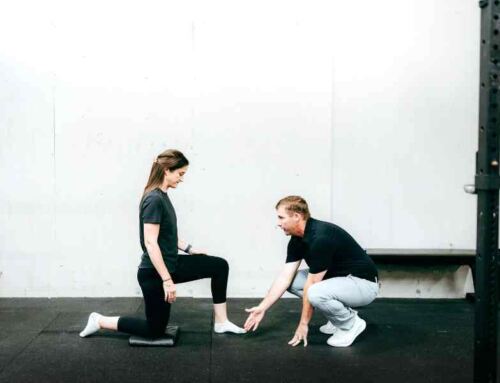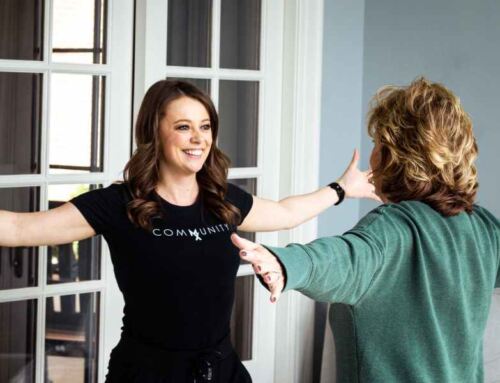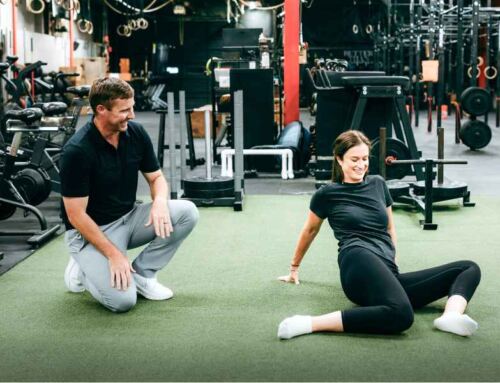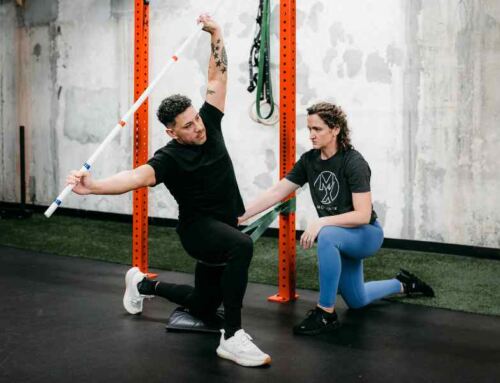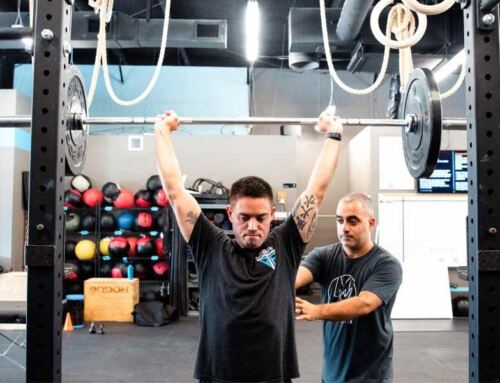Whether you’re a CrossFit athlete executing a squat snatch or a gymnast nailing a cast handstand on bars, you’ve likely heard the cue, “Tuck in your ribs!” It’s not just about the aesthetics of your hollow-body position, it’s a game-changer for strength, balance, and injury prevention.
In CrossFit and gymnastics, where explosive power and precision are non-negotiable, proper ribcage alignment can make or break your performance.
Let’s explore why ribcage position matters, what causes it to go wrong, and how to fix it for better lifts, routines, WODs, and longevity.
Why Ribcage Position Matters
In a neutral ribcage position, the ribs are stacked over the pelvis rather than flaring forward. The result is a strong, stable “cylinder” of support that includes the diaphragm and ribcage at the top, the pelvis and pelvic floor at the base, and the abdominal and back muscles as the sides.
When aligned, this structure delivers:
Efficient Power Transfer
A neutral ribcage helps to engage the core, boosting force in movements like snatches, overhead squats, giants, or tumbling passes.
Better Balance and Control
Proper alignment stabilizes handstand push-ups, pull-ups, or beam skills, reducing wobble and improving consistency.
Injury Prevention
It distributes forces evenly, protecting the lower back, shoulders, and wrists. Research shows that limited shoulder mobility increases wrist injury risk, especially under the 13-14x body weight forces in gymnastics skills or heavy CrossFit lifts [1].
Improved Breathing
A flared ribcage restricts the diaphragm, making it harder to control breathing during high-intensity WODs or critical moments before a clean and jerk.
When the ribs flare, the core disengages, the shoulders overwork, and stress shifts to joints not built to handle it. This “energy leak” makes lifts feel heavier, dynamic movements less fluid, and skills less controlled, all while increasing injury risk over time.

Understanding Ribcage Flare: A Compensation, Not a Habit
Ribcage flare, when the ribs pop forward, isn’t just sloppy form; it’s the body’s attempt to compensate for restricted movement elsewhere.
This is common in CrossFit and gymnastics, where overhead motions like snatches, handstand push-ups, or bar routines are staples. Common causes include:
Limited Shoulder Flexion
Tight lats, pecs, or shoulder joint capsules can prevent full overhead arm movement, forcing the lower back to arch and ribs to flare to “fake” the position in lifts like overhead squats or muscle-ups.
Thoracic Spine Stiffness
The upper back (thoracic spine) needs to extend for proper posture and overhead mechanics. Prolonged slouching (e.g., desk work), repetitive forward-leaning patterns (e.g., rowing or biking in CrossFit), or tight chest muscles can stiffen this area, leading to lumbar overcompensation. Weak upper back muscles (e.g., rhomboids, mid-trapezius) or even past injuries can further limit thoracic mobility [2].
Weak Core
A weak deep core (e.g., transversus abdominis, erectors, or obliques) isn’t able to stabilize the midsection, which can end up causing slouching or the opposite, lumbar hyperextension during heavy lifts or explosive tumbling skills, pushing the ribs forward.
These compensations show up in CrossFit during overhead presses, where athletes arch their backs to get the bar up, or in kipping handstand push-ups, where the ribs flare and form collapses.
In gymnastics, you’ll see a similar pattern of compensation in handstands that sag into the lower back or back handsprings (especially on beam) that lose control.
Over time, this can lead to lower back pain, core instability, or overuse injuries in the shoulders and wrists.
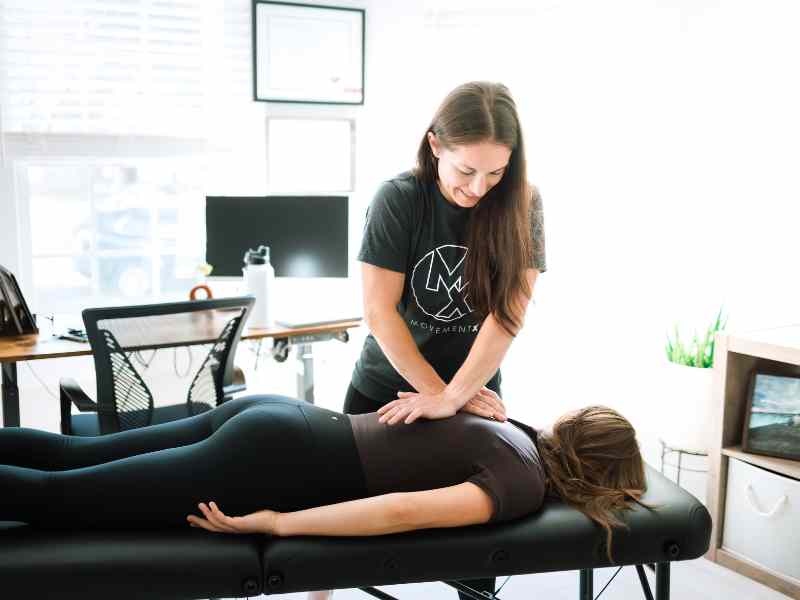
Fixing Ribcage Flare for Better Performance
Correcting ribcage flare means addressing mobility, strength, and movement habits to unlock your potential in your box or gym.
Here are 3 exercises tailored for CrossFit athletes and gymnasts to improve ribcage control:
Anchored Ribcage with Shoulder Blade Retraction
This exercise builds awareness of a neutral ribcage for lifts and kipping movements.
- Stand or sit in front of a mirror
- Draw your ribcage down toward your pelvis, engaging your abs to hold this “anchored” position (think of the braced core you need for a heavy deadlift)
- Slowly pull your shoulder blades back and together without letting your ribs lift, mimicking the shoulder position for a strict press or pull-up
- Take a few breaths, maintaining alignment
- Repeat, focusing on keeping your ribs down, while straightening your upper back
Ribcage Breathing (90-90 Position)
- Lie on your back with hips and knees at 90° (legs on a box, chair, or bench)
- Place one hand on your abdomen, the other on your sternum
- Exhale, drawing your ribs down toward the floor, as if bracing for a max-effort lift
- Inhale, flattening your shoulder blades without losing the “ribs down” position
- Repeat for three breaths.
You can progress by maintaining the initial 90/90 position without the support of the chair or box.
And you can progress even further by extending one leg during the exhale, returning it before the breath ends (like a controlled leg lower in a hollow hold). Alternate legs for 10 reps, keeping ribs anchored.
Wall Angels with Rib Control
- Stand facing a wall, toes and forehead touching it, arms raised with palms facing each and edges of hands touching the wall
- Optionally, use a light resistance band around wrists for extra shoulder activation
- Find your anchored rib position, then lift your palms off the wall without losing alignment (think of maintaining this control in an overhead squat)
- Repeat 10 times
Bonus: Apply this to a wall-facing handstand (CrossFit) or free standing handstand hold (gymnastics), pressing tall through your shoulders while keeping ribs anchored, and head in a neutral position.

Rib Control = Power, Balance, and Longevity
Mastering ribcage control isn’t just about cleaner form, it’s about unlocking your body’s full potential.
A neutral ribcage maximizes core engagement, stabilizes dynamic movements like kipping toes-to-bar or back handsprings, and protects peripheral joints from overuse. It also optimizes diaphragm function for better breathing during grueling WODs or high-pressure routines.
Whether you’re chasing a heavier snatch, a stricter handstand push-up, a steadier beam skill, or fewer aches and pains, ribcage control is the small tweak that delivers big results.
Want to fine-tune your movement and crush your next WOD or routine?
Book a session with me to identify your compensations and move with greater strength, efficiency, and safety.
Let’s make your lifts and skills smoother, stronger, and safer!
References
- McLaren, K., et al. (2015). Impact Shoulder Angles Correlate With Impact Wrist Angles in Standing Back Handsprings in Preadolescent and Adolescent Female Gymnasts. International Journal of Sports Physical Therapy, 10(3), 341-346.
- Caine, D.J., Russell, K., & Lim, L. (2013). Handbook of Sports Medicine and Science: Gymnastics. Wiley-Blackwell.
- For more on diaphragm function, check out this quick YouTube video: https://www.youtube.com/shorts/0WNm1gTHcAc
About the Author
Doctor Jillian Chiappisi is a physical therapist and Board Certified Sports Clinical Specialist in Knoxville, Tennessee. Dr. Jillian specializes in treating gymnasts, circus performers, hybrid athletes, busy moms, yogis, post partum clients, and all forms of active people! Shaped by a 10 year career as a competitive gymnast, Dr. Jillian brings that same energy, discipline, and rigor to her practice to help you move better to live better.



